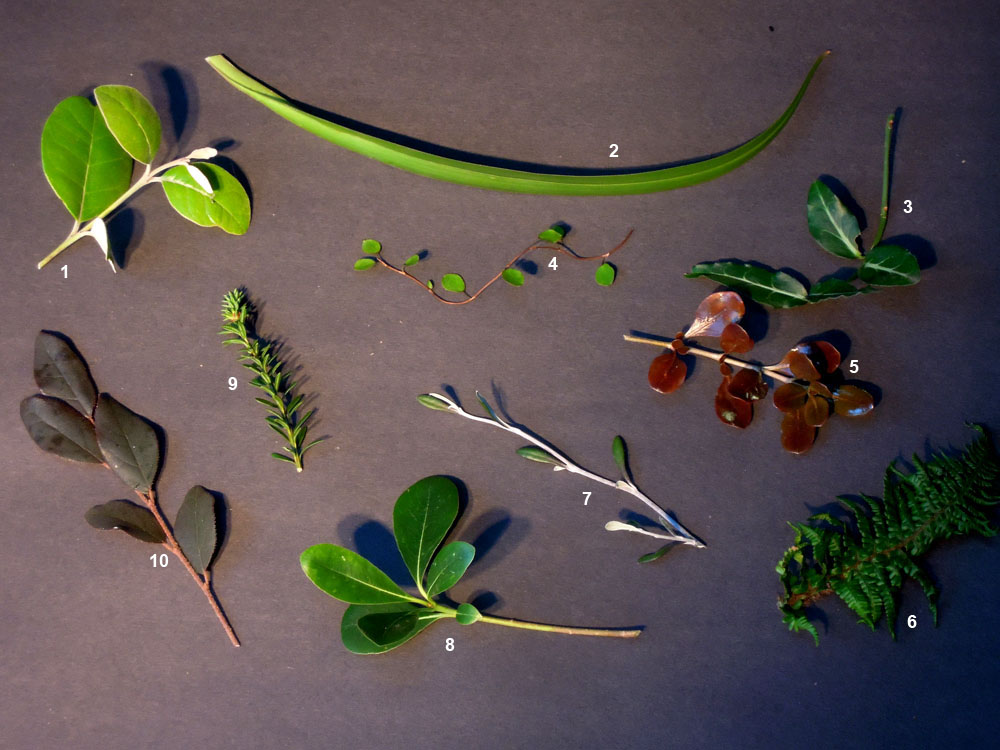Exceptional Evergreens

It is always at this time of year, when the trees have lost most of their leaves, that you can truly see the structure of the garden that forms the rigid skeleton the rest of the garden is supported on. We see classics such as Buxus (box) and Taxus (yew) used for this purpose all the time, but what about some of the more newcomers to the block.
You could conceive that Euonymus is one of those well used evergreens, but even this has had a new introduction in the form of Euonymus fortunei ‘Wolong Ghost’ (3). An evergreen groundcover that works equally as well vertically (if offered support) as it does horizontally. Elegant, narrow, dark leaves with silver veining, form a dense cover which could easily sit under a display of stems from Cornus or Rubus.
Corokia x virgata (7), perhaps does not endear itself to many with its common name of the wire-netting bush, but is used a lot in its native New Zealand as a hedging plant. I’m growing this and Corokia x virgata ‘Frosted Chocolate’, which is being trialled as an alternative to box in the walled garden at RHS Wisley. Given good drainage they could grow to 3 metres but I’m going to try topiarising them. I love the colours in the downy foliage of this, not just green, but brown and grey with striking white stems which look great when lit by the sun.
Other Antipodean introductions include Coprosma repens ‘Pacific Night’ (5), the looking glass plant with its rounded, glossy purple-black leaves; Muehlenbeckia complexa (4) with its tiny dark green leaves on wiry stems could be used as ground cover, as a climber or even trailing down as a curtain; dwarf conifer Podocarpus x ‘Young Rusty’ (9) with its bronze-green foliage which turns a striking rusty red in colder weather; and Dianella tasmanica 'Tas Red' (2) – a diminutive Phormium look-a-like with violet flowers followed by purple berries sitting above the strappy green foliage. This foliage, like the Podocarpus, is another temperature sensitive colour changer.
‘Pittosporum tobira ‘Nana’ (8) is a slow growing, dwarf shrub that has scented flowers in summer. In a sheltered site or against a wall these would definitely work as an alternative to box. Pittosporum tenuifolium ‘Golf Ball’ is a small, naturally rounded shrub with mid-green leaves, so wouldn’t even need clipping.
When you think of ‘evergreens’ you tend to think of the leaves being green, certainly not a plummy colour. Lorepetalum chinense ‘Fire Dance’ (10) has just that. Topped off by pink spider like flowers in late winter, it is these that divulge its witch hazel family status.
Acca sellowiana (Feijoa sellowiana or Pineapple Guava) (1) has glossy evergreen leaves with felty undersides and is currently adding some much needed structure to our vegetable garden. Pale pink flowers in summer are followed in warm years by edible fruits.
And finally Dryopteris Aff. Crispa Congesta (6) is a dwarf evergreen fern, growing to 25cm high, would make a slow growing, but impressive, groundcover with its adorable crinkled leaves. Any of these candidates would happily suit a sheltered garden and should be fine growing in the south of England, bringing fresh life to the old bones of the garden.